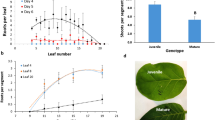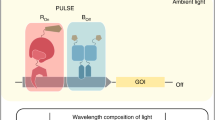Abstract
Minute electric currents of the order of 1–2 microamps stimulate shoot differentiation up to 5-fold in tobacco callus cultures. The location of the first-formed shoots depends on the direction of the current. Similar stimulations of both root and shoot formation have been observed in wheat. It is suggested that the effect is due to the artificial currents controlling the natural electric currents which flow through plant cells. The role of these currents in regulating eukaryotic differentiation is discussed. Possible applications include the rapid regeneration of plantlets from somaclonal variants and genetically engineered protoplast cultures.
This is a preview of subscription content, access via your institution
Access options
Subscribe to this journal
Receive 12 print issues and online access
$209.00 per year
only $17.42 per issue
Buy this article
- Purchase on Springer Link
- Instant access to full article PDF
Prices may be subject to local taxes which are calculated during checkout
Similar content being viewed by others
References
Lund, E.J. 1923. Electrical control of organic polarity in the egg of Fucus. Bot. Gaz. 76: 288–301.
Jaffe, L.F. 1966. Electrical currents through the developing Fucus egg. Proc. Natl. Acad. Sci. U.S.A. 56: 1102–1109.
Robinson, K.R. and Jaffe, L.F. 1975. Polarizing Fucoid eggs drive a calcium current through themselves. Science 187: 70–72.
Peng, H.B. and Jaffe, L.F. 1976. Polarization of Fucoid eggs by steady electrical fields. Develop. Biol. 53: 277–284.
Weisenseel, M.H. and Jaffe, L.F. 1976. The major growth current through Lily pollen tubes enters as K+ and leaves as H+. Planta 133: 1–7.
Novak, B. and Bentrup, F.W. 1972. An electrophysiological study of regeneration in Acetabularia mediterranea. Planta 108: 227–244.
Chen, T.-H. and Jaffe, L.F. 1979. Forced calcium entry and polarized growth of Funaria spores. Planta 144: 401–406.
Jaffe, L.F. and Nuccitelli, R. 1977. Electrical controls of development. Ann. Rev. Biophys. Bioeng. 6: 445–476.
Rathore, K.S. and Goldsworthy, A. 1985. Electrical control of growth in plant tissue cultures. Bio/Technology 3: 253–254.
Goldsworthy, A. and Rathore, K.S. The electrical control of growth in plant tissue cultures: the polar transport of auxin. J. Exp. Bot. In press.
Jaffe, L.F. 1977. Electrophoresis along cell membranes. Nature 265: 600–602.
Poo, M.-m. and Robinson, K.R. 1977. Electrophoresis of concanavalin A receptors along muscle cell membranes. Nature 265: 602–605.
Woodruff, R.I. and Telfer, W.H. 1980. Electrophoresis of proteins in intercellular bridges. Nature 286: 84–86.
Jaffe, L.F., Robinson, K.R. and Nuccitelli, R. 1974. Local cation entry and self-electrophoresis as an intracellular localization mechanism. Ann. N.Y. Acad. Sci. 238: 372–389.
Robinson, K.R. and Jaffe, L.F. 1977. Transcellular ion movement and growth localization in Fucoid eggs and other cells, p. 15–29. In: Water Relations in Membrane Transport in Plants and Animals. Jungreis, A. M., Hodges, T. K., Kleinzeller, A. and Schultz, S. G. (eds.). Academic Press, New York.
Nuccitelli, R. 1984. The involvement of transcellular ion currents and electrical fields in pattern formation, p. 23–46. In: Pattern Formation—A primer in Developmental Biology, Malacinski, G. M. and Bryant, S. V. (eds). Macmillan Publishing Company, London.
Newman, I.A. 1963. Electric potentials and auxin translocation in Avena. Aust. J. Biol. Sci. 16: 629–646.
Weisenseel, M.H., Dorn, A. and Jaffe, L.F. 1979. Natural H+ currents traverse growing roots and root hairs of barley (Hordeum vulgare L.) Plant Physiol. 64: 512–518.
Lund, E.J. 1947. Bioelectric Fields and Growth. The University of Texas Press, Austin.
Brawley, S.H., Wetherell, D.F. and Robinson, K.R. 1984. Electrical polarity in embryos of wild carrot precedes cotyledon differentiation. Proc. Natl. Acad. Sci. U.S.A. 81: 6064–6067.
Trewavas, A. 1982. Possible control points in plant development, p. 7–27. In: The Molecular Biology of Plant Development, Smith, H. and Grierson, D. (eds). Blackwell Scientific Publications, Oxford.
Raven, J.A. 1979. The possible role of membrane electrophoresis in the polar transport of IAA and other solutes in plant tissues. New Phytol 78: 285–291.
Gamborg, O.L., Miller, R.A. and Ojima, K. 1968. Nutrient requirements of suspension cultures of soybean root cells. Exp. Cell Res. 50: 151–158.
Author information
Authors and Affiliations
Rights and permissions
About this article
Cite this article
Rathore, K., Goldsworthy, A. Electrical Control of Shoot Regeneration in Plant Tissue Cultures. Nat Biotechnol 3, 1107–1109 (1985). https://doi.org/10.1038/nbt1285-1107
Received:
Accepted:
Issue Date:
DOI: https://doi.org/10.1038/nbt1285-1107
This article is cited by
-
Vertical and horizontal electric fields stimulate growth and physiological responses in lettuce
Horticulture, Environment, and Biotechnology (2024)



